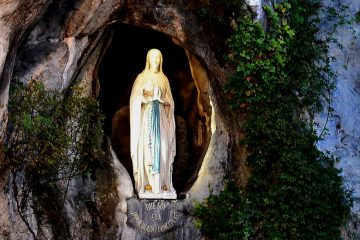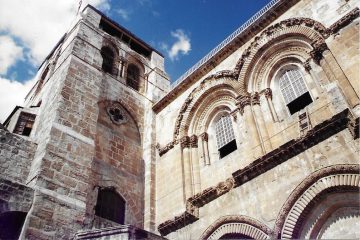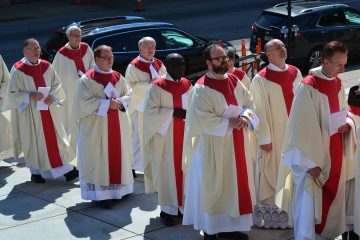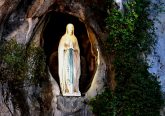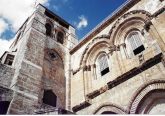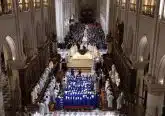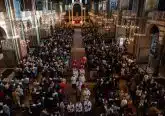When tragedy strikes, don’t turn God into a scapegoat, bishop says
By Carol Glatz
VATICAN CITY (CNS) — Do not turn to superstition or blame God in the aftermath of a deadly tragedy, the bishop of Rieti told people mourning the deaths of those killed by the devastating earthquake that struck central Italy.
God is humanity’s salvation and he “cannot be used as a scapegoat,” Bishop Domenico Pompili said in his homily Aug. 30 at a funeral Mass in the village of Amatrice, which was nearly razed to the ground. The 6.2 quake rumbled across the central Italian regions of Lazio, Mache and Umbria Aug. 24, leaving at least 292 people dead and more than 400 people injured.
The Mass, attended by residents left homeless as well as top government officials, was held under a large tent canopy.
A wooden statue of the crucified Christ, salvaged from the wreckage, was suspended from a rope behind the altar. It hung against a backdrop of concrete and twisted steel from a building that buckled under the weight of its roof; solar panels lay in a jumble on top, like playing cards hastily tossed aside. The mountains of rubble were ringed by a dense forest of trees, lush and green in the pouring rain.
“The question, ‘Where is God?’ shouldn’t get asked afterward, but comes first and at every time for explaining life and death,” he said. Pathetic cliches and reactions bordering on superstition — with talk about fate, bad luck and coincidences — must also be avoided, he added.
Underlining the importance of restoring the vitality and beauty of affected communities, Bishop Pompili said that “to desert these places would be to kill them a second time.” However, the years of rebuilding will require cooperative, “tender and tenacious” effort if they are to avoid the political wrangling and profiteering that often plague Italy’s reconstruction projects.
Pope Francis sent his almoner, Archbishop Konrad Krajewski, to the Mass; the Polish prelate distributed papal rosaries to the families of those who died.
The pope had said he plans to visit the ravaged area and meet survivors “as soon as possible” in order to “bring you personally the solace of faith, the embrace of a father and brother, and the support of Christian hope.”
Before leading a prayer for the deceased and survivors after his Angelus address at the Vatican Aug. 28, the pope expressed his closeness and concern for the people “hard hit by the earthquake” and praised the rapid response of the Italian government and volunteers. He said their efforts showed “how important solidarity is in order to overcome such painful trials.”
Bishop Giovanni D’Ercole of Ascoli Piceno led a state funeral for victims Aug. 27 inside a gymnasium. More than 2,000 people attended, including Italian President Sergio Mattarella and Prime Minister Matteo Renzi. Set before the altar were dozens of caskets covered with flowers and photos of lost loved ones as well as two small white caskets representing all the children killed in the catastrophe.
“It’s fair for people to say, ‘But Lord, where are you?'” he said in his homily. However, if people look deeper, they will find that “the earthquake can take away everything, everything but one thing — the courage of faith.”
“Seismologists try everything to predict an earthquake, but only faith teaches us how to overcome it,” he said.
“Don’t be afraid,” he said. Don’t hesitate to cry out in need, “but make sure you do not lose courage because only together will we be able to rebuild our homes and churches,” he said.
He concelebrated the funeral Mass with Bishop Pompili of Rieti and archbishop of L’Aquila. Bishop D’Ercole had served as auxiliary bishop of L’Aquila in the months after a devastating earthquake there in 2009 left more than 300 people dead and tens of thousands homeless.
The bishop also celebrated a Mass for survivors at an encampment in Arquata del Tronto Aug. 28. Firefighters built a cross made out of two rescue ladders and decorated it with the helmets of first responders. They wove through the rungs a bright red firehose, which took on the shape of limp arms and legs draped around the cross and the image of blood trailing downward.
Archbishop Renato Boccardo of Spoleto-Norcia celebrated a Mass Aug. 26 in one of the many large tents erected in towns and villages to provide provisional shelter for the 2,100 people rendered homeless by the quake and its strong aftershocks.
He visited areas in his archdiocese which were affected by the quake, whose epicenter was close to Norcia — the birthplace of St. Benedict. Civil authorities have condemned all the churches in the area as unusable, he said.
“There is no longer any place of worship in the birthplace of St. Benedict where people can gather to pray,” he told SIR, the news agency of the Italian bishops’ conference, Aug. 27. A local Caritas was to provide two temporary structures to be used for pastoral centers.
– – –
Copyright © 2016 Catholic News Service/U.S. Conference of Catholic Bishops. www.catholicnews.com. All rights reserved. Republishing or redistributing of CNS content, including by framing or similar means without prior permission, is prohibited. You may link to stories on our public site. This copy is for your personal, non-commercial use only. To request permission for republishing or redistributing of CNS content, please contact permissions at [email protected].


